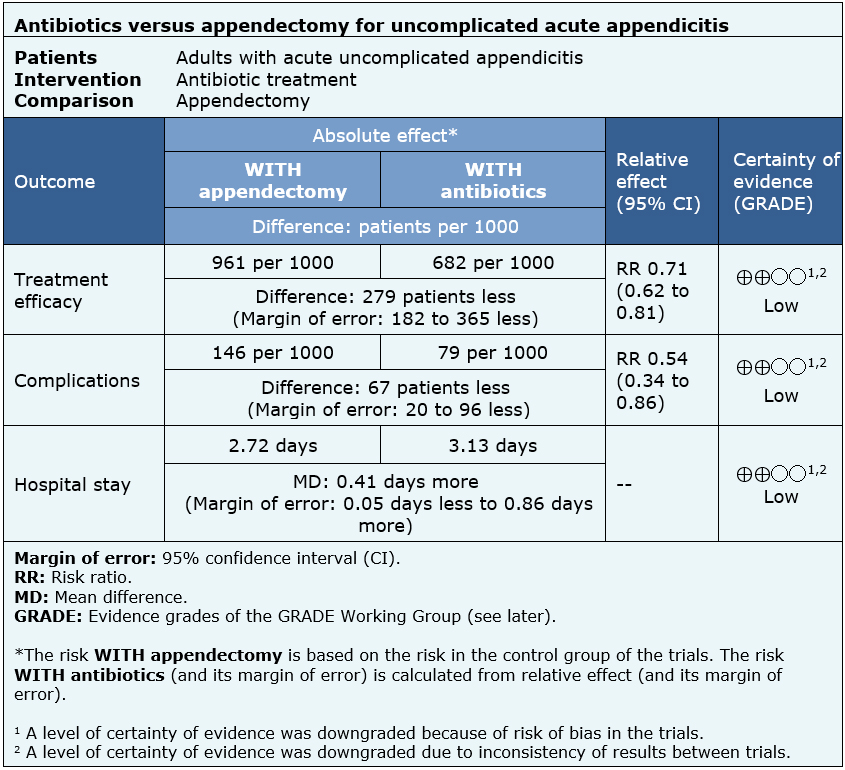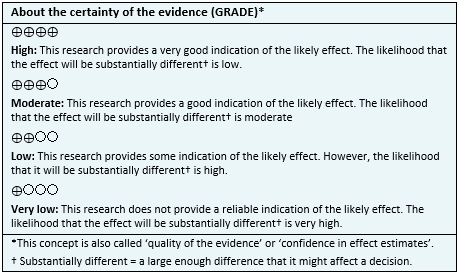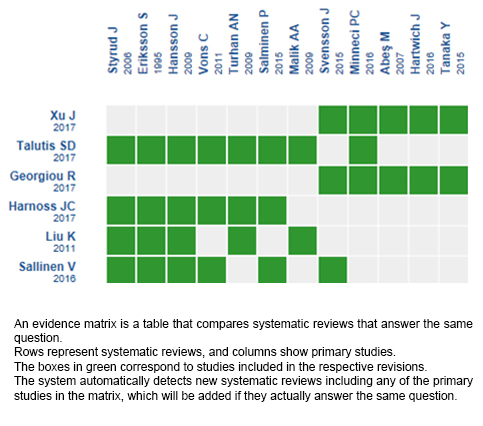Resúmenes Epistemonikos
← vista completaPublicado el 11 de julio de 2018 | http://doi.org/10.5867/medwave.2018.04.7229
¿Es seguro y efectivo tratar la apendicitis aguda no complicada con antibióticos?- Primera actualización
Are antibiotics a safe and effective treatment for acute uncomplicated appendicitis?- First update
Abstract
UPDATE This Living FRISBEE (Living FRIendly Summary of the Body of Evidence using Epistemonikos) is an update of the summary published in January 2016.
INTRODUCTION Appendicitis is a typical cause of acute abdominal pain and the most frequent cause of emergency abdominal surgery. In the last two decades, increasing evidence has been published about the use of antibiotics as an exclusive treatment for acute appendicitis.
METHODS To answer this question, we used Epistemonikos, the largest database of systematic reviews in health, which is maintained through searches from multiple sources of information, including MEDLINE, EMBASE, Cochrane, among others. We extracted the data from the identified reviews, reanalyzed the data from the primary studies, performed a meta-analysis and prepared a summary of findings table using the GRADE approach.
RESULTS AND CONCLUSIONS We identified 23 systematic reviews including 28 primary studies, of which eight were randomized trials. We concluded the exclusive use of antibiotics for the treatment of uncomplicated acute appendicitis could be less effective than appendectomy, but it might be associated with a lower rate of complications.
About this update
This Living FRISBEE (Living Friendly Summary of the Body of Evidence using Epistemonikos) is an update of the summary published in January 2016 (doi: 10.5867/medwave.2016.6375), based on 14 new systematic reviews including two new randomized trials not included in previous reviews. In addition, we added a trial that had not been previously incorporated into the analysis, and a trial previously incorporated was removed because it was retracted due to plagiarism. Finally, the outcome ‘major complications’ was replaced by ‘complications’, since most identified systematic reviews analyzed this variable as the outcome of choice. The incorporation of this new evidence leads to a change in the direction of the effect on complications, and therefore to changes in the key messages and considerations for decision-making.
Problem
Acute appendicitis is a common cause of acute abdominal pain and the most frequent cause of emergency abdominal surgery, with an estimated life incidence between 7 and 14% [1],[2]. Since the 1890s, when McBurney described early appendectomy as the therapy of choice for acute appendicitis [3],[4], surgery has become the mainstay for the treatment of this condition, drastically decreasing its mortality rate [5].
The treatment of acute appendicitis with antibiotics as an initial strategy was historically reserved for patients with several days of evolution of the inflammatory process, who presented a plastron or appendicular abscess, to avoid major surgery [2]. In 1953, Harrison reported 42 out of 47 cases of acute appendicitis successfully treated with antibiotics only. Coldrey published in 1959 an article with 471 cases of acute appendicitis treated conservatively, with only one death, nine patients requiring abscess drainage and only 48 patients requiring appendectomy [6]. In the last two decades, the production of research on the use of antibiotics as an exclusive treatment for acute appendicitis has steadily increased, so it is important to synthesize the existing evidence.
Methods
To answer the question, we used Epistemonikos, the largest database of systematic reviews in health, which is maintained by screening multiple information sources, including MEDLINE, EMBASE, Cochrane, among others, to identify systematic reviews and their included primary studies. We extracted data from the identified reviews and reanalyzed data from primary studies included in those reviews. With this information, we generated a structured summary denominated FRISBEE (Friendly Summary of Body of Evidence using Epistemonikos) using a pre-established format, which includes key messages, a summary of the body of evidence (presented as an evidence matrix in Epistemonikos), meta-analysis of the total of studies when it is possible, a summary of findings table following the GRADE approach and a table of other considerations for decision-making.
|
Key messages
|
About the body of evidence for this question
|
What is the evidence. |
We found 23 systematic reviews [5],[6],[7],[8],[9],[10],[11],[12], This table and the summary in general are based on seven randomized trials [28],[29],[30],[31],[32],[33],[38], since the observational studies did not increase the certainty of the existing evidence, nor did they provide relevant additional information. |
|
What types of patients were included* |
All trials included patients with suspected acute appendicitis. Six trials [28],[29],[30],[31],[32],[33] excluded children and one trial also excluded women [32]. One trial only included pediatric patients between 5 and 15 years old [38]. |
|
What types of interventions were included* |
Six trials used intravenous antibiotics as the initial treatment, of which one did so for 24 hours [29], three for 48 hours [28],[32],[38] and two for 72 hours [31],[33]. Of these, two trials used cefotaxime associated with tinidazole [28,32], one used cefotaxime associated with metronidazole [29], one used ampicillin associated with gentamicin and metronidazole [31], one used meropenem associated with metronidazole [38] and one used ertapenem [33]. The remaining trial [30] used intravenous amoxicillin with clavulanic acid only if the patient presented nausea or vomiting and for a time that was not specified. All trials continued the treatment using oral antibiotics. One trial completed eight days [30] and six completed ten days [28],[29],[31],[32],[33],[38]. During the oral phase, two trials used the combination of ofloxacin with tinidazole [28],[32], two used ciprofloxacin with metronidazole [29],[38], one used levofloxacin with metronidazole [33], one used amoxicillin with clavulanic acid [30] and one trial did not specify the antibiotic used orally [31]. All trials compared antibiotic treatment against surgery. Two trials performed open appendectomy [28],[33], one performed only laparoscopic appendectomy [38] and the remaining four trials performed the procedure open or laparoscopic according to surgeon's preference [29],[30],[31],[32]. |
|
What types of outcomes |
The trials measured multiple outcomes, which were pooled by the systematic reviews as follows:
All trials followed their patients up to 12 months. |
* The information about primary studies is extracted from the systematic reviews identified, unless otherwise specified.
Summary of findings
The information on the effects of antibiotics or surgical treatment for uncomplicated acute appendicitis is based on seven randomized trials [28],[29],[30],[31],[32],[33],[38] that included 1770 participants, of whom 858 were initially treated with antibiotics and 912 with appendectomy. All trials reported treatment efficacy, complications and hospital stay.
The summary of findings is the following:
- The use of antibiotics for the treatment of uncomplicated acute appendicitis might be less effective than appendectomy, but the certainty of the evidence is low.
- The use of antibiotics for the treatment of uncomplicated acute appendicitis might be associated with fewer complications than appendectomy, but the certainty of the evidence is low.
- The use of antibiotics for the treatment of uncomplicated acute appendicitis might be associated with a longer hospital stay than appendectomy, but the certainty of the evidence is low.

| Following the link to access the interactive version of this table (Interactive Summary of Findings – iSoF) |

Other considerations for decision-making
|
To whom this evidence does and does not apply |
|
| About the outcomes included in this summary |
|
| Balance between benefits and risks, and certainty of the evidence |
|
| Resource considerations |
|
| What would patients and their doctors think about this intervention |
|
|
Differences between this summary and other sources |
|
| Could this evidence change in the future? |
|
How we conducted this summary
Using automated and collaborative means, we compiled all the relevant evidence for the question of interest and we present it as a matrix of evidence.

Follow the link to access the interactive version: Antibiotics versus appendectomy for uncomplicated acute appendicitis.
Notes
The upper portion of the matrix of evidence will display a warning of “new evidence” if new systematic reviews are published after the publication of this summary. Even though the project considers the periodical update of these summaries, users are invited to comment in Medwave or to contact the authors through email if they find new evidence and the summary should be updated earlier.
After creating an account in Epistemonikos, users will be able to save the matrixes and to receive automated notifications any time new evidence potentially relevant for the question appears.
This article is part of the Epistemonikos Evidence Synthesis project. It is elaborated with a pre-established methodology, following rigorous methodological standards and internal peer review process. Each of these articles corresponds to a summary, denominated FRISBEE (Friendly Summary of Body of Evidence using Epistemonikos), whose main objective is to synthesize the body of evidence for a specific question, with a friendly format to clinical professionals. Its main resources are based on the evidence matrix of Epistemonikos and analysis of results using GRADE methodology. Further details of the methods for developing this FRISBEE are described here (http://dx.doi.org/10.5867/medwave.2014.06.5997)
Epistemonikos foundation is a non-for-profit organization aiming to bring information closer to health decision-makers with technology. Its main development is Epistemonikos database (www.epistemonikos.org).
Potential conflicts of interest
The authors do not have relevant interests to declare.

